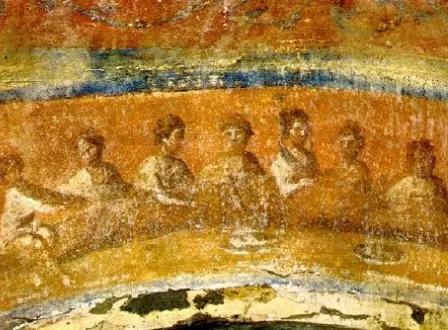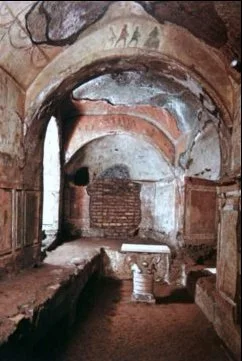Altars are (or ought to be at least), architecturally and liturgically, the central focal point of the interior of our churches. Given their evident importance, it is no surprise that there can be much in the way of disagreement as to what the ideal form of the altar is. Debates reign about free-standing altars versus altars with grand reredoses.
It was through the consideration of the different forms of the Christian altar, particularly through the pursuits of the Liturgical Movement, that the idea arose of taking a brief look at the history and development of its forms.
Early Christian Antiquity
If we look to the earliest time of Christian antiquity, there are two early forms of altar that can be identified. One is those of the house-churches, which were wooden and in table form. Some of the Eucharistic frescoes of the Roman catacombs may give some sense of this form:
It was through the consideration of the different forms of the Christian altar, particularly through the pursuits of the Liturgical Movement, that the idea arose of taking a brief look at the history and development of its forms.
Early Christian Antiquity
If we look to the earliest time of Christian antiquity, there are two early forms of altar that can be identified. One is those of the house-churches, which were wooden and in table form. Some of the Eucharistic frescoes of the Roman catacombs may give some sense of this form:
(The "Fractio Panis" fresco in the Capella Greca of the Roman catacomb of St. Priscilla)
The second form was the use of the stone tombs of the martyrs as altars. This custom is thought to trace to the first quarter of the 2nd century. Marble tops were placed upon the tombs for the Mass to be celebrated upon.
The Fractio Panis fresco of the Capella Greca, which belongs to this period is located in the apse directly above a small cavity which Wilpert supposes to have contained the relics of a martyr, and it is highly probable that the stone covering this tomb served as an altar. (The Catholic Encyclopedia)
(Beneath the Fractio Panis fresco)
Both forms seem quite tied to the circumstances of their day of course, which is to be expected. At this time in ecclesial history, the Church found itself in times of persecution, being therefore hidden away in houses and cemeteries. To that extent, altar forms would be rather dictated by these circumstances it would seem reasonable to conclude.
The Era of the Great Roman Basilicas
The Construction of the Earlier Altars
Wooden altars were still to be found after this time and into the middle ages, though gradually, stone altars came to be more and more preferred.
The Catholic Encyclopedia suggests:
...the idea of the stone altar, the use of which afterwards became universal in the West, is evidently derived from the custom of celebrating the anniversaries and other feasts in honour of those who died for the Faith. Probably, the custom itself was suggested by the message in the Apocalypse (vi, 9) "I saw under the altar the souls of them that were slain for the word of God." With the age of peace, and especially under the pontificate of Pope Damasus (366-384), basilicas and chapels were erected in Rome and elsewhere in honour of the most famous martyrs, and the altars, when at all possible, were located directly above their tombs. The "Liber Pontificalis" attributes to Pope Felix I (269-274) a decree to the effect that Mass should be celebrated on the tombs of the martyrs ... it is clear from the testimony of this authority that the custom alluded to was regarded at the beginning of the sixth century as very ancient... The great veneration in which the martyrs were held from the fourth century had considerable influence in effecting two changes of importance with regard to altars. The stone slab enclosing the martyr's grave suggested the stone altar, and the presence of the martyr's relics beneath the altar was responsible for the tomblike under-structure known as the confessio. The use of stone altars in the East in the fourth century is attested by St. Gregory of Nyssa (P.G., XLVI, 581) and St. John Chrysostom (Hom. in I Cor., xx); and in the West, from the sixth century... (The Catholic Encyclopedia, "History of the Christian Altar")
With regard to the martyrs, it is further suggested that in these times, great care was taken to not
disturb the remains of the martyrs, and so rather than the martyrs being brought to the church and her altar, the altar and church were brought to the place of the martyrs tomb.
An example of this can be seen in San Giorgio in Rome, where the sanctuary is raised above the nave level so that the altar might be built overtop the tomb of a martyr without disturbing the tomb.
The Ciborium Magnum
It is during this same period, the 4th century, that we see the advent of the ciborium magnum. This was a structure that covered the altar, being set upon four pillars. It forms one of the very great and significant forms of the Christian altar, and one which saw some revival during the Liturgical Movement. This particular feature gave what were otherwise, historically, smaller and simpler altars a certain architectural and symbolic prominence and some suggest it may have also been a visual echo of the way in which some martyrs tombs were covered, such as those of St. Peter and St. Paul.
An interesting description of the great ciborium that was originally in the Lateran basilica is included in the Catholic Encyclopedia:
The altars of the basilicas erected by Constantine at Rome were surmounted by ciboria, one of which, in the Lateran, was known as a fastigium and is described with some detail in the "Liber Pontificalis". The roof was of silver... the columns were probably of marble or of porphyry, like those of St. Peter's. On the front of the ciborium was ... Christ enthroned in the midst of the Apostles... On the opposite side, facing the apse, Our Lord was again represented enthroned, but surrounded by four Angels with spears... The interior of the Lateran Ciborium was covered with gold, and from the centre hung a chandelier (farus) "of purest gold, with fifty dolphins of purest gold weighing fifty pounds, with chains weighing twenty-five pounds". Suspended from the arches of the ciborium, or in close proximity to the altar, were "four crowns of purest gold, with twenty dolphins, each fifteen pounds, and before the altar was a chandelier of gold, with eighty dolphins, in which pure nard was burned".
These ciboria, at some point and in some instances at least (such as the great basilicas of Rome), also had the presence of veils of curtains which would be suspended around it and closed or opened at particular points within the liturgy. Cyril Pocknee notes in his work, The Christian Altar, the accounts of various veils donated by Popes for this purpose. Further, the rods and other mechanisms which were used for suspending these veils are still in evidence in a number of cases.
An example of what this might have looked like with the veils drawn, may be seen in a mosaic in the church of St. George in Thessalonika.
A rare modern day example from Rome gives some sense of this arrangement with the veils open:
The Form and Decoration of the Altar
While the altars of today tend to be longer, rectangular structures, in the first millennium they were rather more square in construction, rather like many altars of the Christian East are quite often yet found:
An example of this within the Latin context may be seen in a fresco found in the basilica church of San Clemente in Rome:
Josef Jungmann suggests in The Mass of the Roman Rite that "until the 11th century the altar tables were rarely more than 3 or 4 feet square". (p. 82)
In addition to the size of the altar, what will additionally be noted is the lack of anything upon the altar itself but that which was used for the Eucharistic sacrifice.
In his work, The Liturgical Altar, Geoffrey Webb notes that the early altars of the periods we are discussing were draped with fine silk or linen but no candlesticks were upon the altar itself. Rather, "any lights used were also hung from [the ciborium], or stood on the steps, or on the podium -- that is, the screen of open columns between the altar and nave, which may still be seen in the Church of Santa Maria in Cosmedin in Rome." Other sources note similarly.
(The Church of Santa Maria in Cosmedin)
Where the sacrament was reserved at the altar, no tabernacle placed upon the altar. Instead, the use of a hanging pyx in the form of a dove was used, which was hung from the ciborium.
This concludes the first of three parts. In the second part, we will consider the continuing development of the altar through the remainder of the middle ages, and up to the modern period. Part three will consider the modern period.










